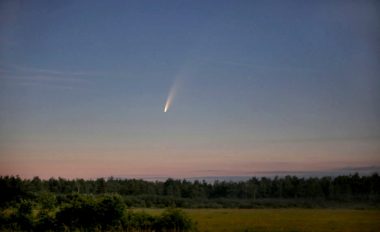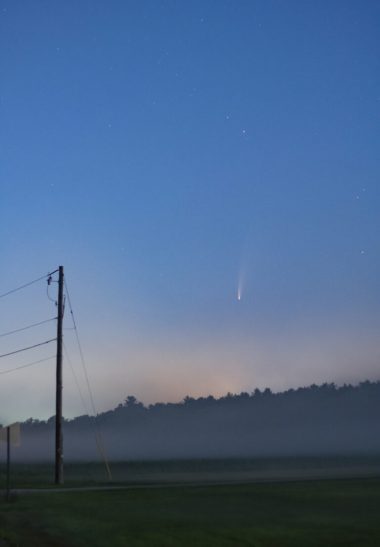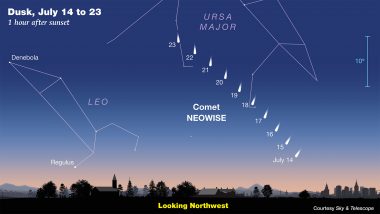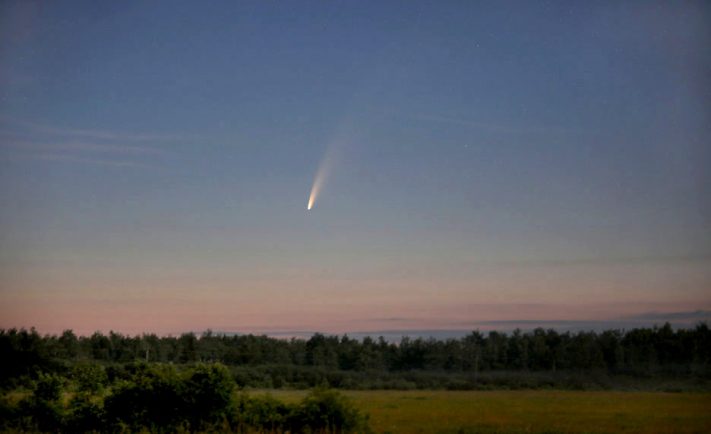One of the brightest comets in decades is passing Earth. Here’s how to see it…
An unexpected celestial newcomer, after falling towards the Sun for more than 3,000 years, is now making an appearance in our skies.
Named after NASA’s infrared space telescope that discovered it on March 27th, Comet Neowise is delighting stargazers across the world and should be visible (when skies are clear) in the Northern Hemisphere until mid-August.

Pic Caption: Comet NEOWISE (C/2020 F3) became part of the summer landscape at dawn on July 8, 2020. Details: 100-mm lens, f/2.8, ISO 400, 4-second exposure. Bob King, Sky & Telescope
Comet Neowise (catalogued C/2020 F3) passed just 27.4 million miles from the Sun, inside the orbit of Mercury on July 3rd and has now emerged into view delighting stargazers across the globe.
NASA said: “A comet has suddenly become visible to the unaided eye. Comet C/2020 F3 was discovered in late March and brightened as it reached its closest approach to the Sun, inside the orbit of Mercury, late last week.
“The interplanetary iceberg survived solar heating, so far, and is now becoming closer to the Earth as it starts its long trek back to the outer Solar System.”
Astronauts on the International Space Station (ISS) also saw the comet. Cosmonaut Ivan Vagner even took a photo of Neowise and said: it’s “the brightest one over the last 7 years. Its tail is quite clearly visible from the space station!”
Scientists say the comet will be closest to the Earth on July 23. But don’t worry there’s no danger of it colliding with us – it will still be about 64 million miles away!
What exactly is a comet?
A comet is an icy, small Solar System body that, when passing close to the Sun, warms and begins to release gases, a process called outgassing. This produces a visible atmosphere and sometimes also a tail.
According to NASA comets are actually “frozen leftovers from the formation of the solar system composed of dust, rock and ices. They range from a few miles to tens of miles wide, but as they orbit closer to the sun, they heat up and spew gases and dust into a glowing head that can be larger than a planet. This material forms a tail that stretches millions of miles.”
How to spot Comet Neowise
According to Space.com, until now, the comet has been accessible only to those waking up at the break of dawn and scanning the sky near the horizon. But “things are going to be getting better for skywatchers in the days ahead.” If skies are clear the comet should now be visible all through the night until the middle of August.
The best way to see the comet in mid-July is to look for the Plough (also known as the the Big Dipper or Ursa Major). Comet Neowise will be to the right, and below the Plough close to the horizon from mid July and then directly below it by July 25.
If there are clear skies you should be able to see it moving westwards across the sky – pretty low to the horizon.
Downloading a night sky app onto your phone, such as SkyView will help you to pick out the right constellation.
Happy comet gazing!
Let us know if you manage to get a pic of Comet Neowise. Please email it to us at: [email protected]
DID YOU KNOW? The comet was discovered using the Near Earth Object Wide-field Infrared Survey Explorer – hence the name NEOWISE.

The comet as it appeared before dawn on July 9th. According to S&T Associate Editor Sean Walker, “In my 10×60 Apogee binoculars, the comet sports a bright coma and a bifurcated tail filling about half the binocular field of view. A fantastic sight!” Details: Nikon D3300 and 50-mm f/2 Nikkor lens, 4-second exposure at ISO 1600. Sean Walker / Sky & Telescope

This chart shows the appearance of Comet NEOWISE on the evenings of July 14–23. Sky & Telescope

Daily positions for Comet NEOWISE (C/2020 F3) are shown for 0h UT through July 30th. To convert to our time zone, subtract 4 hours and back up to the previous date for EDT (5 hours; for CDT, 6 hours for MDT, and 7 hours for PDT). For example, July 10th at 0h UT = July 9th at 8 p.m. EDT. The comet’s apparition begins in the morning sky but it soon becomes an evening object as it zips from Auriga to Ursa Major. Sky & Telescope
With thanks to Sky & Telescope for making their pictures and illustrations available to our readers. For more information on Comet Neowise and other astronomical matters check out their website at https://skyandtelescope.org/











